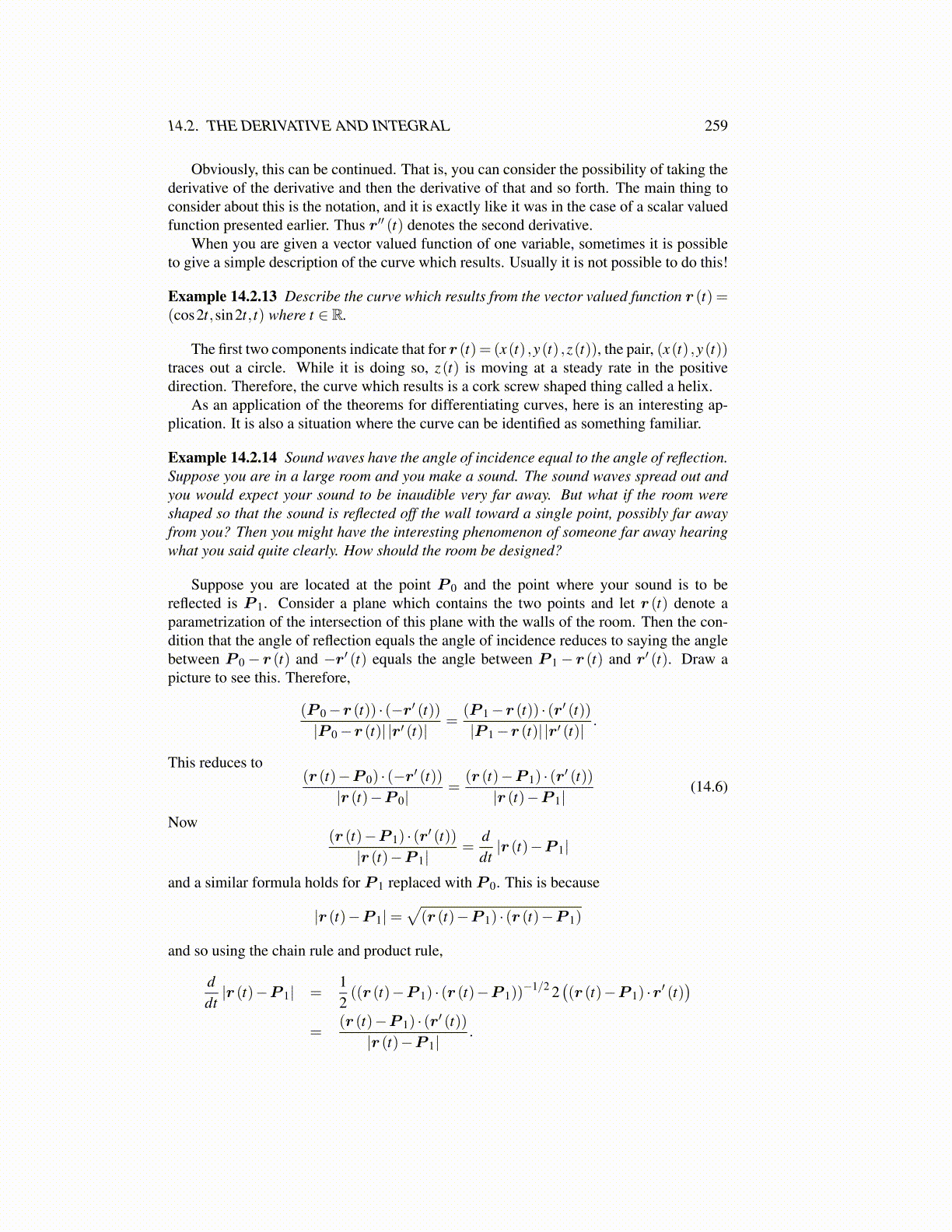
14.2. THE DERIVATIVE AND INTEGRAL 259
Obviously, this can be continued. That is, you can consider the possibility of taking thederivative of the derivative and then the derivative of that and so forth. The main thing toconsider about this is the notation, and it is exactly like it was in the case of a scalar valuedfunction presented earlier. Thus r′′ (t) denotes the second derivative.
When you are given a vector valued function of one variable, sometimes it is possibleto give a simple description of the curve which results. Usually it is not possible to do this!
Example 14.2.13 Describe the curve which results from the vector valued function r (t) =(cos2t,sin2t, t) where t ∈ R.
The first two components indicate that for r (t)= (x(t) ,y(t) ,z(t)), the pair, (x(t) ,y(t))traces out a circle. While it is doing so, z(t) is moving at a steady rate in the positivedirection. Therefore, the curve which results is a cork screw shaped thing called a helix.
As an application of the theorems for differentiating curves, here is an interesting ap-plication. It is also a situation where the curve can be identified as something familiar.
Example 14.2.14 Sound waves have the angle of incidence equal to the angle of reflection.Suppose you are in a large room and you make a sound. The sound waves spread out andyou would expect your sound to be inaudible very far away. But what if the room wereshaped so that the sound is reflected off the wall toward a single point, possibly far awayfrom you? Then you might have the interesting phenomenon of someone far away hearingwhat you said quite clearly. How should the room be designed?
Suppose you are located at the point P 0 and the point where your sound is to bereflected is P 1. Consider a plane which contains the two points and let r (t) denote aparametrization of the intersection of this plane with the walls of the room. Then the con-dition that the angle of reflection equals the angle of incidence reduces to saying the anglebetween P 0− r (t) and −r′ (t) equals the angle between P 1− r (t) and r′ (t). Draw apicture to see this. Therefore,
(P 0−r (t)) · (−r′ (t))|P 0−r (t)| |r′ (t)|
=(P 1−r (t)) · (r′ (t))|P 1−r (t)| |r′ (t)|
.
This reduces to(r (t)−P 0) · (−r′ (t))
|r (t)−P 0|=
(r (t)−P 1) · (r′ (t))|r (t)−P 1|
(14.6)
Now(r (t)−P 1) · (r′ (t))|r (t)−P 1|
=ddt|r (t)−P 1|
and a similar formula holds for P 1 replaced with P 0. This is because
|r (t)−P 1|=√(r (t)−P 1) · (r (t)−P 1)
and so using the chain rule and product rule,
ddt|r (t)−P 1| =
12((r (t)−P 1) · (r (t)−P 1))
−1/2 2((r (t)−P 1) ·r′ (t)
)=
(r (t)−P 1) · (r′ (t))|r (t)−P 1|
.